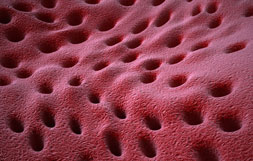We don't have a heart attack warning sticker, because otherwise there would be no need to do roughly the same thing with much heavier and more cumbersome equipment. Experts in the United Kingdom have developed a chemical imaging method that will allow to photograph and understand the extent of the sclerotic blockage in the artery and also to know many more details about it

A state-of-the-art chemical imaging method could, one day, help in the fight against atherosclerosis - so claims a study published by researchers from Imperial College London in the August 2009 issue of the scientific journal Journal of the Royal Society Interface.
Atherosclerosis is the disease at the root of most heart attacks and strokes and is characterized by wounds in the arteries, which consist of fats, collagen and cells. The wounds cause the walls of the arteries to thicken and harden - a result that greatly limits the normal flow of blood in the body and can cause the arteries to burst, which will lead to heart attacks and strokes. Understanding the exact chemical composition of these wounds is extremely important since people with higher levels of a fat called cholesteryl ester are more prone to it.
The research team behind the state-of-the-art imaging method, also known as "ATR-FTIR imaging" (Attenuated Total Reflection Fourier Transform Infrared Spectroscopic Imaging), believes that with further improvement the method will become an extremely useful tool for doctors who wish to examine wounds of this type. For example, through the combination of fiber optic technology and the state-of-the-art imaging method, the researchers claim that doctors will be able to perform a real-time diagnosis of patients with atherosclerosis in order to gauge the progress of the disease and locate the patients with the greatest risk of developing complications as a result.
Today, doctors use ultrasound imaging methods to estimate the size and location of wounds, but they are also required to take a biopsy (tissue sample) of the wound to determine its chemical composition. This procedure is complex and invasive, of course.
The researchers claim that the modern imaging method will be able to improve the current imaging methods since it will be able to combine with other chemical and imaging diagnostic methods, which will enable a more comprehensive and accurate understanding of the patient's condition in just one procedure. In the current study, the researchers demonstrated how the state-of-the-art method was able to diagnose the exact composition and size of this type of wound and even the levels of the biological substances elastin, collagen and cholesteryl ester that were found in them.
The new method works using infrared radiation to identify different chemical compounds, which are mapped by an array of detectors to obtain a "chemical image".
The researchers used a method to examine the effects of age and an amino acid called arginine on the composition of the wounds in rabbits fed cholesterol. The study seems to support the claim that an arginine diet is able to remove the lesions in the arteries of adult rabbits.
The researchers point out that further research is still needed so that the new method can be used in the treatment of human patients.

One response
What is the problem with creating a substance that combines with the bad cholesterol and keeping it away from the artery? Why do we need all those stents and catheters? Apparently someone will lose a lot of money with such a drug on the market. It just doesn't seem logical to me that there is a problem of a lack of technology to solve the problem.